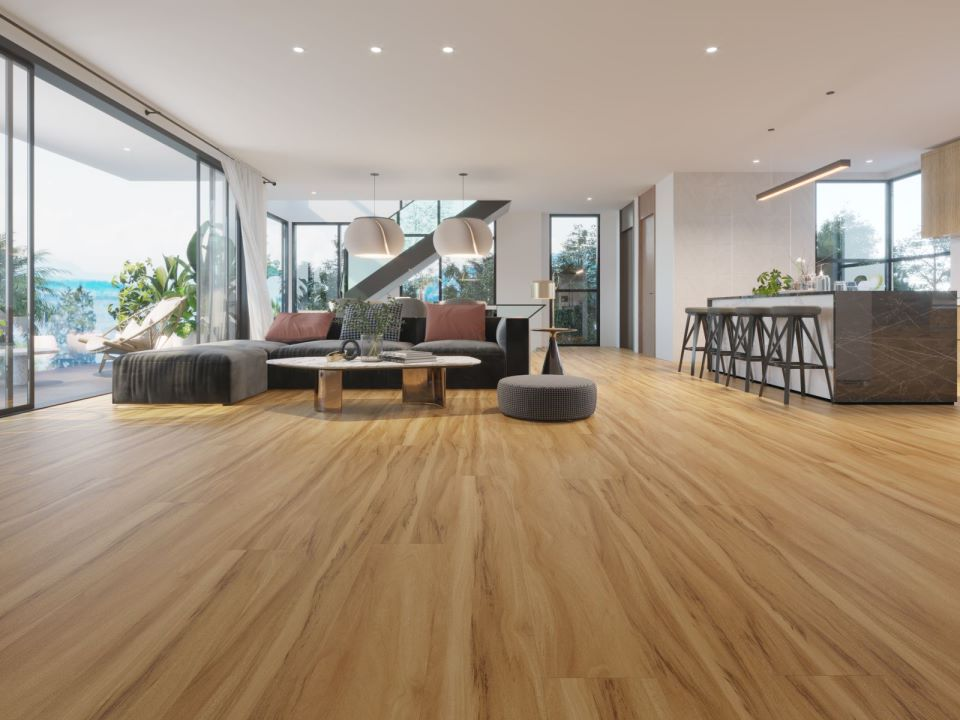In Europe, flooring choices are not only about home aesthetics, but also deeply tied to local climate, environmental standards, and lifestyle habits. From classical estates to modern apartments, consumers have stringent requirements for flooring durability, environmental friendliness, and functionality. Among various materials, SPC flooring is emerging as a new force in the European market, redefining the standards for flooring selection with its unique advantages.
Core Demands of the European Flooring Market
Most regions in Europe have a temperate maritime climate, characterized by year-round humidity and rainfall, with colder winters and widespread use of underfloor heating systems indoors. This necessitates extremely high standards for flooring in terms of moisture resistance, stability, and temperature resistance—traditional solid wood flooring is prone to warping due to humidity changes, while ordinary composite flooring may release harmful substances in long-term underfloor heating environments. These pain points have driven the demand for new flooring materials.
Additionally, Europe is one of the regions with the strictest environmental standards globally, with low formaldehyde emissions, recyclability, and low-carbon production becoming the “entry barriers” for flooring products. The EU’s E1 environmental standard (formaldehyde emission ≤ 0.1 mg/m³) and CE certification are the red lines that all flooring products entering the European market must cross. Furthermore, European households place a strong emphasis on the “ease of maintenance” of flooring, with their busy lifestyles leading them to prefer durable products that do not require frequent waxing or polishing.
SPC Flooring Precisely Matches European Demands
SPC flooring (stone-plastic composite flooring) is made primarily from polyvinyl chloride (PVC) and natural stone powder through high-temperature compression. Its characteristics align closely with European market demands:
Exceptional moisture resistance, unaffected by humid climates: SPC flooring has a density of 1.5–1.8 g/cm³, making it impermeable to water molecules. Even in perpetually humid regions like Northern Europe or the Mediterranean coast, it does not swell or warp, making it ideal for moisture-prone areas like kitchens and bathrooms.
Excellent thermal stability and compatibility with underfloor heating systems: Its molecular structure remains stable and resistant to deformation, making it fully compatible with the water-based and electric underfloor heating systems commonly used in European households. It does not release harmful gases even after prolonged heating, meeting EU environmental standards.
Zero formaldehyde + recyclable, aligning with environmental principles: SPC flooring does not require adhesives during production, eliminating formaldehyde emissions from the source, far exceeding EU E1 standards. Some brands use recyclable materials in production, aligning with Europe’s “circular economy” policy direction, and easily passing CE, REACH, and other certifications.
Durable and robust, suitable for diverse scenarios: The surface is covered with a 0.3-0.7mm wear-resistant layer, achieving AC4-grade wear resistance (commercial light-duty standard), capable of withstanding furniture friction, pet scratching, and even high-traffic commercial spaces. Stains wipe away effortlessly, requiring no special maintenance, perfectly suited for European residential and commercial spaces.
The rise of SPC flooring in Europe
In recent years, SPC flooring’s market share in Europe has grown at an annual rate of 15%, particularly favored by young families and commercial spaces. This success is not only due to its performance advantages but also benefits from “localized innovation” in design:
Strong stylistic adaptability: SPC flooring can realistically mimic the textures of solid wood, marble, and cement, accurately reproducing styles from Nordic minimalist wood finishes to French-inspired vintage parquet patterns, seamlessly integrating with Europe’s diverse architectural aesthetics.
Convenient and efficient installation: Using a lock-and-fold design, no adhesive is required for installation, and it can be directly laid over existing surfaces (such as tiles or wood floors), significantly reducing installation costs and timeframes, aligning with the high labor costs prevalent in European markets.
The cost-effective choice for commercial settings: In high-traffic environments like hotels, office buildings, and shopping malls, SPC flooring offers notable durability and low maintenance costs, with a lifespan of 15–20 years, resulting in significantly lower overall costs compared to traditional flooring.
In Europe, flooring selection has long transcended the realm of “decoration,” becoming an extension of lifestyle and environmental values. SPC flooring addresses the pain points of traditional flooring in European environments with its comprehensive advantages of moisture resistance, stability, environmental friendliness, and durability, rising from an “alternative option” to the “preferred material.”
For companies planning to expand into the European market, SPC flooring is not just a product but a key to unlocking the European market—it addresses local climate challenges through technological innovation, meets the world’s strictest environmental standards, and wins consumer favor with its practical design. In the future, as Europe’s demand for green buildings and sustainable materials continues to grow, the market potential of SPC flooring will be further unlocked, becoming a vital bridge connecting Chinese manufacturing with European living standards.
Our Email: info@gkbmgroup.com
Post time: Aug-01-2025






